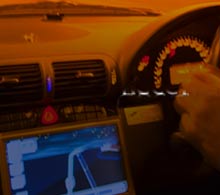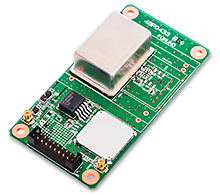Articles for ITS market ETC (Electronic Toll Collection) and ETC2.0. Current situation and projected future
Japanese ETC system is the most advanced ITS solution in the world today
Japanese car navigation systems, VICS (Vehicle Information and Communication System) and ETC are recognized as the most advanced, practical use ITS (Intelligent Transport System) available anywhere.
According to the Ministry of Land, Infrastructure and Transport of Japan, as of March 2016, the number of car navigation systems has spread to approximately 70 million units. The traffic information system VICS is 50 million units and the automatic toll collection system ETC is 53 million units. Such an achievement is the direct result of the government's continuous efforts. The Japanese government has been involved in research on 172 services in nine different fields, in cooperation with the relevant five ministries and agencies with private sectors from 1999.
Among these Japanese ITS strategies, the ITS segment was introduced in 2011. In the ITS area we initiated dynamic route guidance that expands VICS, previously limited to prefecture-specific traffic information to the nationwide level. Furthermore, safe driving support utilizing “big data” such as informing drivers of falling objects and broken vehicles on the highway. Also driver notifications of weather conditions ahead in long tunnels, etc. were incorporated in the ETC equipment.
In 2015 the service was further improved with integration in the cloud, including traffic jam information and reducing toll road charges by changing the route. The name was also changed from ETC to ETC 2.0. The biggest difference between normal ETC and ETC 2.0 is the amount of bidirectional data communication between the on-board device and the roadside infrastructure.
The four focused areas of ETC 2.0
As of October 2017 the numbers of roadside ETC 2.0 units are about 1,700 on highways and about 1,900 on national highways. There are typically two types of data collected from the on-vehicle devices by the roadside devices.
One is the running history data including time, position (latitude / longitude) and speed. Data collection occurs at every 200 meters of mileage change or when the heading direction changes by 45 degrees or more. The other behavior is based on history data, time, front and rear left/right acceleration and change of yaw angular velocity with respect to horizontal direction. These are collected when the acceleration changes are =>0.25 G or the yaw angular velocity changes by =>8.5 degrees/second.
Such data is called probe data and integrates and aggregates data to a dedicated server. This data is sent to the road administrator such as the capital high speed.
Based on these technologies, the directions that ETC 2.0 aims for are (1) Wise investment in road infrastructure, (2) A fee system that reduces congestion and accidents by managing traffic, (3) Setting smart fees using an adoption of a toll system corresponding to mileage, etc. and (4) Smart logistics management to optimize truck transport.
Efforts continue for improvements
When the normal ETC users are traveling on a highway, if they get off to use the general road gas station or other facilities they are charged the express fee to get back on. This is because the Ministry of Land, Infrastructure and Transport of Japan defines it as "A withdrawal to facilities outside the expressway". There is an effort to improve this situation by using ETC 2.0. A demonstration has been done on several expressways in Japan including the Kanetsu expressway in Gunma prefecture, Shin Tomei expressway in Aichi prefecture and Sanyo expressway in Yamaguchi prefecture etc. The demonstration experiment is to not re-charge when users get off the expressway and meets the condition of the temporary withdrawal.
In the demonstration, DSRC (small range communication) equipment which is same as ETC 2.0 roadside system was installed at service stations. The DSRC recognizes vehicles arriving from the expressway. As of October 2017 there are about 100 sections where resting facilities including highway service and another area are separated by more than 25 kilometers in Japan. The Ministry of Land, Infrastructure and Transport of Japan is considering the “non-recharge temporary withdrawal” for those sections.
In addition to this there is another idea to reduce charges. If ETC 2.0 users take a detour due to a traffic jam, the charge reduces. For example, ETC 2.0 users take the Kenodo expressway instead of going through the central area roads in Tokyo. This is an area where Japan’s Ministry of Land, Infrastructure and Transport is trying to control traffic by using price differences based on the traffic situation.
There is also an idea for cases including disasters and large-scale accidents where the users are not re-charged when they get off the expressway temporarily and then get back on again.
From another point of view, simplification of traffic permission in truck logistics is being implemented and is called “Special car gold system”. In the case of large-sized transport vehicles, it is necessary to apply for permission from the administrators of each expressway and also apply for the normal road traffic permit certification in advance. Managing big data using running history simplifies the application process which leads to reduced costs for both truck operators and road managers.
As of November 2017 ETC 2.0 has shipped about 1.2 million units. It is more than 2% of the normal ETC and is expected to increase.
In the future as various new ETC 2.0 services are put into practical use, the transition from the normal ETC to ETC 2.0 is expected. In addition according to the officials of the Ministry of Land, Infrastructure and Transport's ITS Promotion Office it is likely that as ETC 2.0 continues, the service which uses captured images of in-vehicle cameras will be controlled by the cloud .
Writer introduction

Mr. Kenji Momota Automotive journalist
His major is the world automotive industry and he is also familiar with the energy industry, IT and the aging society problem as the related fields. He acts around the world based in Japan and USA and writes for the general magazines, the technology journals and the automotive related media etc.
He is also commentator of motor race and world's motor show on TV program based on his career of the driver of Indy Racing League and NASCAR. In recent years, he has been covering about a paradigm shift from developed countries to developing countries, the motorized vehicle like EV and the telematics.
FURUNO ITS Journal
Click here for the latest articles after 2022 (in Japanese)2022
- The "realistic" self-driving roadmap shown by the Japanese government and a hands-on report on the latest Subaru EyeSight X
- Will FCVs (Fuel Cell Vehicles) Become Popular? ~New Movement in Toyota and Honda~
- The 'Complete' online sales of new cars start in Japan. Will this new way of buying cars take root?
- Many Firsts! On-Site Report from Tokyo Auto Salon 2022 - The author, who knows what goes on behind the scenes, looks back on 40 years of history. -
2021
- "Moving toward zero traffic fatalities for four-wheeled and two-wheeled vehicles globally in 2050" ~Experience on Honda's latest safety technologies~
- Tsuneishi Shipbuilding's building and DX, an exclusive visit to the main factory
- Japan's Smart City: New Moves toward Practical Use
- When will self-driving buses (service cars) be put to "full-scale" practical use?
- Utilization vehicle data during disasters
- Toyota-led Connected Technology to Transform Commercial Vehicle Business -From light trucks to large trucks and buses-
- Toyota enters the connected car "Personalization" business
- Japanese automakers' carbon-neutral strategies swept up in ESG investment
- Drive experience of the latest autonomous vehicle models and advanced driving support systems
- Will carbon neutrality accelerate the trend to strengthen LCA (Life Cycle Assessment)?
- Semiconductor shortage exposes realities of the automotive industry
- Online Autonomous Driving Contest Enhancing development of Human Resources
2020
- What happens to CASE when gas cars are banned in Japan?
- When will Flying Cars be launched?
- Expectation vs. reality:Autonomous Driving in Japan
- V2X, Becoming increasingly important in autonomous driving
- Technology of Subaru “EyeSight X”
- Lifestyle-oriented French cars gain popularity in Japan
- Human-oriented smart cities are wanted
- MaaS and CASE, how would automotive industry change after COVID-19?
- The beginning of virtualization era, triggered by COVID-19
- Trend of EV shift and consumer demands
- TOYOTA Press conference about ADAS - Releasing algorithm for "sudden acceleration suppression during attempted sudden acceleration" free of charge -
- The Japanese automotive industry in 2020 - 3 turning points -
- "Using a smartphone while driving" and "Level 3 automated driving"
2019
- Motor show business model is at a turning point - Tokyo Motor Show Report -
- Commercialization and monetization of MaaS - ITS World Congress Singapore Report -
- Android Automotive pays attention to V2X - Report from the Frankfurt Motor Show 2019 in Germany -
- Automobile Distribution Revolution and DCM (Data Communication Module)
- Connected business potential and newly proposed "eMaaS" by Honda
- 5G services for practical use are multiplying
- Connectivity technologies attracting attention due to frequent traffic accidents
- Shanghai Motor Show report -SUV, EV, Automated car & 5G-
- Drone Business roadmap and updates to Michibiki (Quasi-Zenith Satellite System)
- MaaS (Mobility as a Service) "town development." Full-scale promotion for a national project
- CES organizer states "Data Period in 2020s." Transformation of the Automotive Industry in CES, US "-CES2019 Report-"
- "Return to Origin" directed towards the age of change, automatic operation and connectivity
2018
- New proposal for Private Car Automated Driving Level and other Hot 5G Technology Topics
- Standardized EV charging infrastructure concerns in Europe, US, Japan and China - Kobe EVS 31 field report -
- Touring a pure car carrier and a test drive of the latest hybrid car
- Planning stage products are exhibited at the newly established visualized mobility service "TOYOTA MOBILITY SHOWROOM".
- Potential “Community Car-share” program promoted by local residents
- CES Asia Report 2108
- Companies attempt new Vehicle-to-Infrastructure communications, including traffic volume measurements and vehicle positioning. -ITS Asia Pacific Forum in Fukuoka-
- Geneva show in Switzerland. Flying cars and MaaS (Mobility as a Service) were hot topics.
- EV (Electric Vehicle) proposals by country
- MaaS competition through service mobilization, M & A and technical field collaboration is accelerating. - The CES 2018 Report -
2017
- Big data’s initiative and fight for the automotive industry. Cooperation among companies becomes increasingly important.
- Connected car and road-to-vehicle communication automatic operation
- ETC (Electronic Toll Collection) and ETC2.0. Current situation and projected future
- Rapid development of sharing economy
- Germany is first to recognize level 3 automated driving
- ITS EU 2017 Field Reports -Automatic Operation and the eCall-
- From Infotainment to ITS, the competitive area is spreading in the car big data industry.
- GTC (GPU Technology Conference) Report and the de facto standardization of AI (artificial intelligence)
- Renesas' new challenge! "e-AI Solution" and "Renesas Autonomy"
- The Automobile industry is shifting from a manufacturing industry to a service industry.
- The movement toward accident countermeasures for aging drivers in Japan
- Fusion of ride sharing and fully automated driving is advancing in the USA.
2016
- Overview of the Quasi-Zenith Satellite System (QZSS) and advancements toward full-scale practical use including the Tokyo Olympic Games - G-space EXPO 2016 report-
- Japan’s automated driving project "SIP-adus" will be a large demonstration experiment.
- The International Home Care & Rehabilitation Exhibition. There were many car manufactures with exhibits booths at this show.
- Japanese car manufacturers starting to concentrate on strengthening the ADAS system
- A new movement of legislation for autonomous cars
- Cyber Security and “AGL”, the new OS for automotive are hot topics in the connected car industry
- “High precision 3D map” the key future of autonomous car and pedestrian dead reckoning
- Chinese “BAT” is accelerating their business in the EV (Electric Vehicle) market
- Tesla's original connection to Taiwan and the new transportation system technologies.
- "The main topic" of the Geneva Motor Show was how to strengthen "pedestrian protection"
- The probe data business is getting more competitive
- Reporting directly from the 2016 CES show "Data services will soon become the main revenue source of automotive industry"
2015
- Do the automated driving systems need the GNSS (Global Navigation Satellite System) ?
- ETC Version 2.0 is coming soon. A new service was announced at the Tokyo Motor Show and the possibility that is could be used as a device for older drivers.
- "Connected Horizon" and "eHorizon". Germany's leading parts supplier accelerates strengthening of "Big Data" for business



 Recommendations for future ITS presented by the Japanese government.
Recommendations for future ITS presented by the Japanese government. Explanation of the development of ITS technology.
Explanation of the development of ITS technology. ETC 2.0 (Exhibition)
ETC 2.0 (Exhibition) Japanese ETC technology being exported overseas, including Singapore.
Japanese ETC technology being exported overseas, including Singapore. GPS/GNSS Receiver&Chips and Modules (positioning and timing)
GPS/GNSS Receiver&Chips and Modules (positioning and timing)